- Offensive Techniques & Strategies
Early Offense
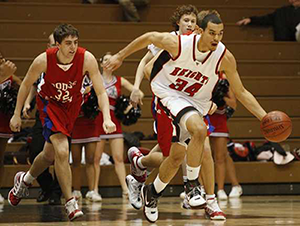
Why the Need for Early Offense?
The main reason for early offense, accompanied by flow action, is to force the defense to react rather than act! This simply put is to advance the ball quickly into the front court areas and attack before the defense is able to become organized into a disruptive force.
As defensive specialists over the many years of coaching, we have found the most difficult teams to defend were the ones with offenses that pushed the ball into the front court hash mark areas in the time span of 2 to 3 seconds. This early offense push creates quick medium jump shots, or penetration lay-ups, or kick out passes for scores to occur before the defense had a chance to set up and disrupt any organized set play.
We have also found that when teams walked the ball up the court, they were much easier to defend because the defense was able to get its players back into positions near the basket were they could execute pressure denials, traps to disrupt the offensive flow and to force rushed shots as time on the clock became a factor.
| Keys to Success | Thoughts to Consider | Installing Early Offense | Case for Defense |

Keys to Success
Before exploring the "How's" along with the "Whys" and "Whens" of Early Offense, it is often helpful to see the whole picture before the pieces of the puzzle are then put together. Strive to develop the following offensive mentality, attitudes, and abilities:
Counter defensive pressure before it takes its toll with early offense initiative.
Take the initiative with Early Offense and counter defensive pressure before it takes its toll.
Look to break on every possession.
Move from push to flow to continuity phases of early offense without hesitation.
Play disruptive, tenacious defense
Tough defense enhances the effectiveness of Early Offense.
Force opponents into taking bad or rushed shots, and turnovers in order to create easy transition baskets.
Tenacious defense enhances the opportunities and effectiveness of Early Offense.
Rebound with authority and determination
Establish good rebound positioning by boxing out.
Execute an effective outlet/inbound pass.
Fake the pass and lob pass or bust out on dribble when opponent overplays or tries to intercept the outlet/inbound pass.
Initial receiver should receive the outlet/inbound pass with back to the sideline in order to see the floor.
Push the ball at all times
Wings must run wide lanes (3 feet from sideline) and see the ball.
Point must advance the ball with a hard speed dribble into the front court within 3-5 seconds.
Keep head and eyes up and analyze defensive deployment prior to crossing half court.
Must attack and score (finish) against all out numbered defensive situations.
Minimize the dribble and pass ahead whenever possible.
Point never penetrates beyond the top of the circle except to shoot a lay up.
On long passes always lead the receiver to the basket (block).
Flow into set offense without disruption
Do not allow the defense time to organize and set up.
Take advantage of any defensive player(s) out of position.
Recognize and take advantage of player mismatches.
End the offensive flow with an organized continuity offense
Move directly into continuity offense when the set offensive flow does not result in a good shot.
Players must stay on balance and maintain poise as shot clock winds down.
Get the ball into the hands of best offensive players.
Go to offensive boards with determined aggressiveness
Scoring is the reward of a successful early offensive scenario.
Assume, however, that every shot will be missed and establish inside rebounding position (box out the defensive rebounder).

Some Thoughts To Consider
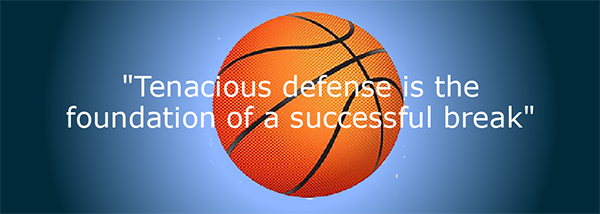
Transition begins with defense. Good defense provides for offensive mistakes and errors which are the foundation of a successful break.
You cannot break without the ball. Go get it.
Always look for the fast break opportunity on every possession.
Never start break from dribble. Start dribble from run.
A quick but safe outlet pass is the key to the fast break.
Do not dribble when it is possible to pass ahead.
When throwing a long pass, lead receiver to the basket (elbow).
Anticipate and fill lanes quickly. Run wide and see the ball.
Do not expect to get a lay-up every time. Look for the open jumper or bank shot.
Last person down court does not cross half court until the break is stopped.
Quick transition is a must in attacking zone defenses.
Must be in better physical shape than any opponent.
Receive passes with feet in air and make a jump stops.
Go to the offensive boards. Must score to be successful.
Most errors and turnovers are committed during the scoring phase of the break.

Game Strategies
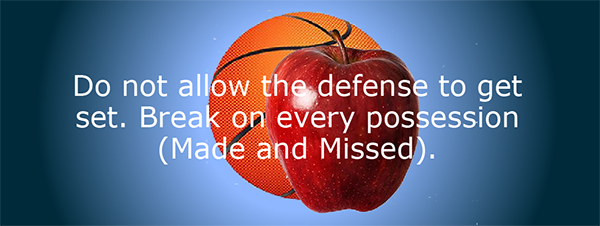
Play disruptive, tenacious defense. Tough defense enhances the effectiveness of Early Offense.
-
Look to break on every possession. Made & Missed shots.
Move directly from Push to Flow to Continuity without hesitation.
Scout your opponent. Players need to know what defensive tactics to anticipate during the game especially full or half court presses.
When scouting is not possible, scout your opponent during the game.
Don't be a spectator and watch the ball during the game. Be conscience and alert to any defensive changes or adjustments, especially after substitutions and timeouts.

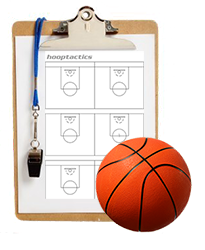
Installing an Early Offense
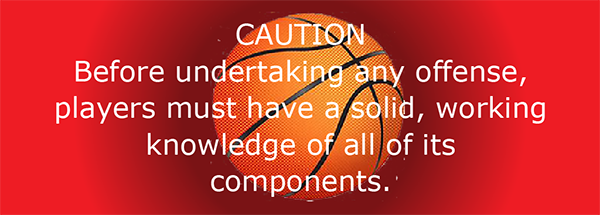
The key to the success of an Early Offense is in its precise execution and coordination. Get coaching done prior to, not during a game. Coach players not the system. It's not what you run, but how you run it that counts. Use the time tested "Whole-Part-Whole" method of teaching. Be creative and design your own offensive breakdown drills that will fit your specific needs and player abilities. Insist in correct spacing and timing along with precise footwork and execution at all times. Bad habits can be practiced as well as good ones.
| Coaching Objectives | Whole-Part-Whole Method | Breakdown Drills |
Coaching Objectives
-
To develop the ability and attitude to look to break on every possession.
-
To develop the ability to "Box Out" and establish good inside rebounding position.
-
To develop the ability and intelligence to make the proper outlet/inbound pass.
-
To develop the ability to kick (pass) the ball ahead and advance the ball quickly under control.
-
To develop the ability to see the floor and make good decisions to counter various defensive pressures.
-
To develop the ability to attack and score against the out numbered situations.
-
To develop the ability and habit to anticipate missed shots and go to the offensive boards.
Teaching & Implementation

Whole-Part-Whole Method
Introduce Early Offense goals and options, using visual means when available. On the court, demonstrate and explain all of the player roles and responsibilities. Then have the players walk through these basic options along with their defensive reads and counters. Next, employing the "Whole-Part-Whole Method" break down the Early offense into its components using a series of progressive breaksdown drills. One-on-One, Two Player Break, Three Player Break, Four Player Break and Five Player Break drills. Review and refine as needed during the rest of the season.
Lastly, go live, motor skills must be learned at game speed. You want to practice against good defense. Don't wait until game time. Motivate the defense. For example, have the defense make 5-6 stops (combination of defensive rebounds, offensive turnovers, and steals) before they can go to offense. No dummy defense! The toughest defense you face all season should be in practice. The offense will probably struggle at first. However, players will learn to adapt to the importance of creating leads and attacking defensive pressure.
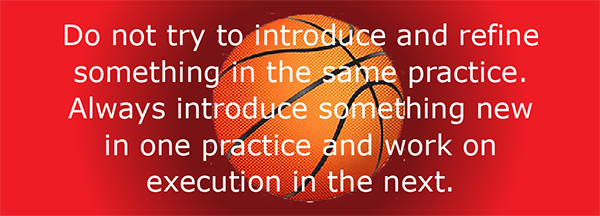
Drills for Skills
Proven Transition Drills to Improve Individual Player Skills & Team Performance
CAUTION: Be a skills coach not a drill coach. Drills are just vehicles to teach and refine basketball skills and techniques. Pay close attention to details and demand proper footwork and execution at all times.
Drill: Wolf: One-on-One Full Court
Drill: Two Player Break Series
Drill: Three Player Break Series
Drill: Post Fly Three Player Break
Drill: "Michigan" Three Player Break
Drill: 3-on-2 / 2-on-1 Full Court
Drill: Continuous 3-on-2 with Trail
Drill: 5 Player Break (Back-to-Back-to-Back)
Drill: Longest Run: Free Throw & Press
Drill: Half and Full Court Scrimmaging
Note: These breakdown drills are not only excellent in developing a strong transition game, but also great for preseason conditioning.

The Case for the Defense
When teams continuously push the ball up the court and flow into early offense, it can prevent or hinder the best of preplanned defensive disruption scenarios. However, by applying defensive pressure immediately, it will not only disrupt any fast break and early offense flow, but it can also catch a team unprepared to counter defensive pressure on missed shots off guard, resulting in easy steals and baskets.
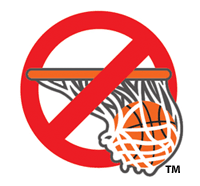
Continue and learn about defensive transition and proven ways to combat early offenses.
© 2025 HoopTactics All Rights Reserved.

